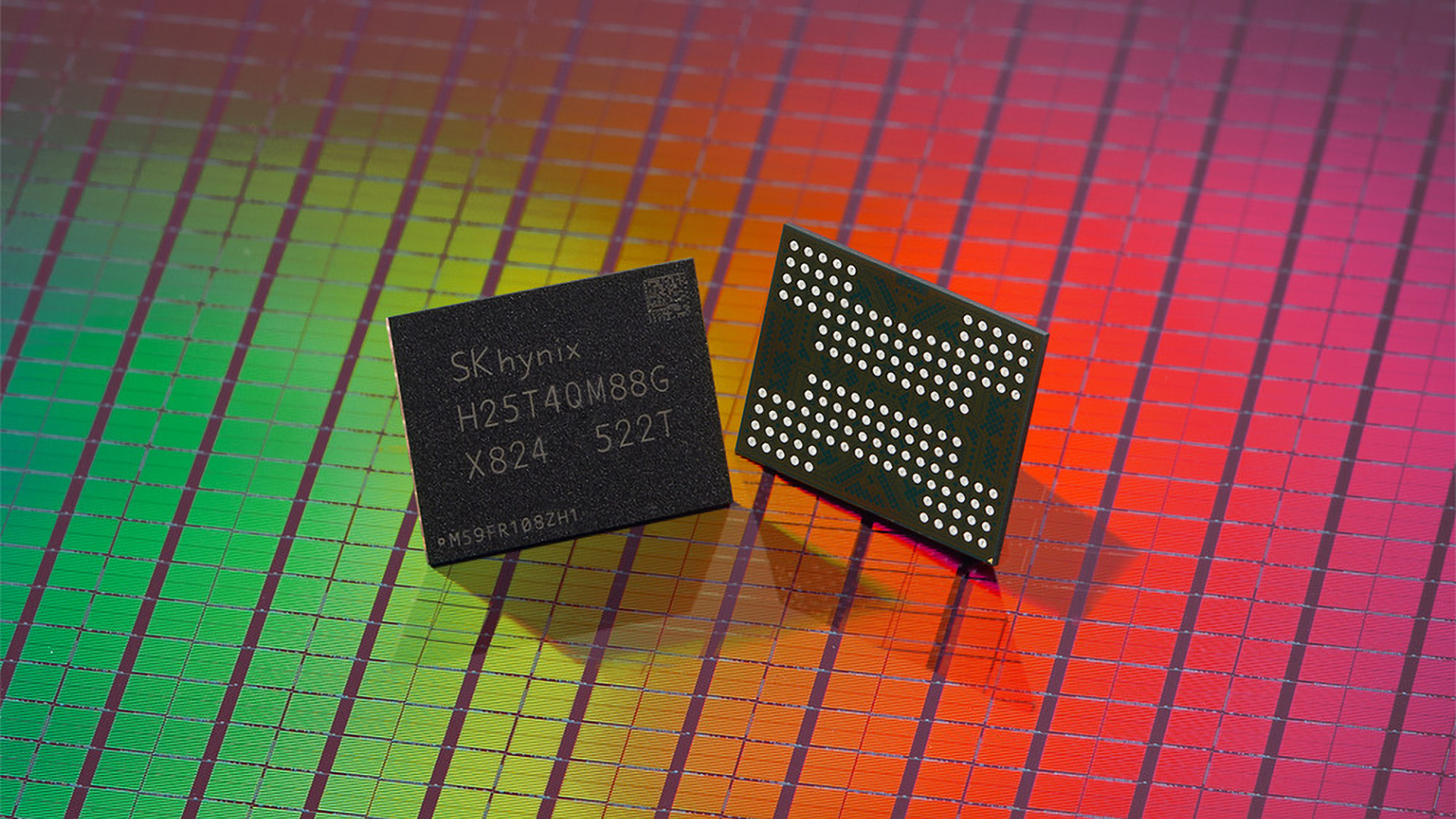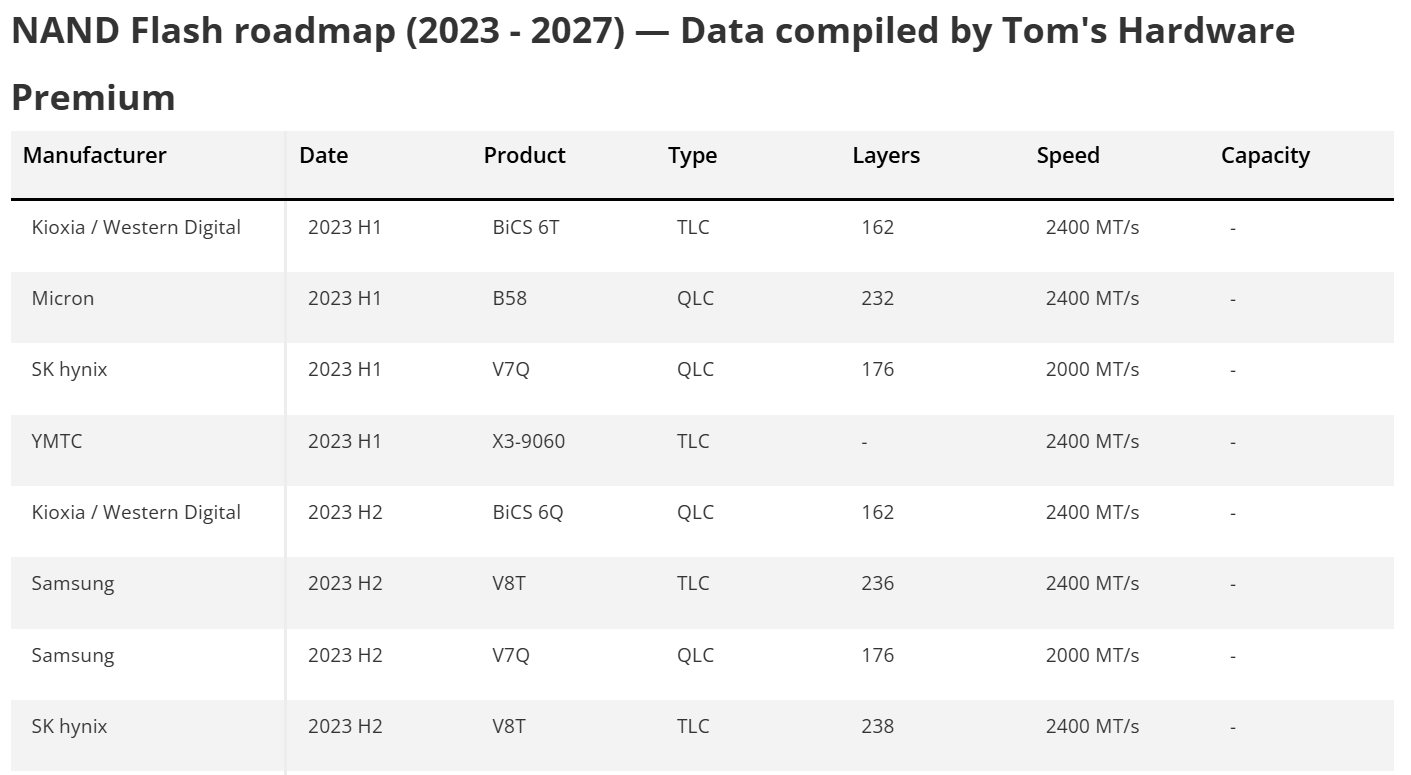SK hynix announces mass production of its 2Tb 3D QLC NAND — cheaper high-capacity consumer drives and 244TB enterprise SSDs incoming

SK hynix on Monday said it had commenced mass production of its 321-layer, 2Tb 3D QLC NAND memory devices that promise to enable ultra-high-capacity SSDs — up to 244TB and beyond — for data center use as well as relatively inexpensive high-capacity drives for client PCs that will rival some of the best SSDs around.

Want more? We've got an exclusive roadmap to the future of 3D NAND flash — only for subscribers of Tom's Hardware Premium.
SK hynix's 321-layer 2Tb (256GB) 3D QLC NAND memory devices belong to the company's V9Q lineup of products, featuring an input/output interface of 3200 MT/s, which is just a tad slower than 3600 MT/s sported by leading-edge 3D TLC NAND ICs, such as the company's own upcoming V9T 321L 3D TLC NAND. In addition, the new 2Tb V9Q ICs feature six planes (up from four, presumably, in previous-generation 3D QLC NAND devices), which enables more parallel work, markedly improving multi-read speed.
The manufacturer claims that its 2Tb V9Q device boasts a 56% higher write performance as well as an 18% higher read performance compared to its outdated V7Q devices from 2023. The performance boost can be attributed to both higher I/O and enhanced internal architecture. Also, the company claims that the new 2Tb V9Q IC is also 23% more efficient in write operations, which likely implies on-process improvements and circuit-level optimizations (perhaps reduced write voltage?) compared to the previous generation.
While 2Tb 3D QLC NAND devices will also start to emerge from various manufacturers, the key thing about SK hynix's V9Q is that it uses the company's latest 321-layer process technology, which is supposed to make it cheaper to produce compared to ICs by competitors. As a result, SK hynix will be able to build cheaper SSDs, a clear competitive advantage.
Initially, the company will apply its 321-layer 2Tb 3D QLC NAND devices to its client SSDs. For example, a 2TB drive will require only eight 2Tb V9Q ICs, which can be packaged in one or two packages, greatly lowering the company's costs.
Eventually, SK hynix's 321-layer 2Tb 3D QLC NAND will be used for enterprise-grade SSDs, including the 244TB product that is currently in development. That drive will use SK hynix's unique 32DP packaging technology that enables the company to bundle 32 2Tb devices into a single package.
"With the start of mass production, we have significantly strengthened our high-capacity product portfolio and secured cost competitiveness," said Jeong Woopyo, Head of NAND Development at SK hynix. "We will make a major leap forward as a full-stack AI memory provider, in line with the explosive growth in AI demand and high-performance requirements in the data center market."
Get Tom's Hardware's best news and in-depth reviews, straight to your inbox.
Follow Tom's Hardware on Google News to get our up-to-date news, analysis, and reviews in your feeds. Make sure to click the Follow button.

Anton Shilov is a contributing writer at Tom’s Hardware. Over the past couple of decades, he has covered everything from CPUs and GPUs to supercomputers and from modern process technologies and latest fab tools to high-tech industry trends.
-
dwd999 Apparently they are saying 1st Half of next year, which might mean we'll see some consumer m.2s at CES or Computex. I'll be eagerly anticipating that.Reply -
Stomx TLC with its 1000 P/E endurance cycles and around 2TB sizes probably OK for consumer SSDs (though looks like today potential degradation of my third in 5 years NVMe caused my Linux instability) but at 200TB sizes probability to encounter non-recoverable error increases 100x.Reply
And at $20,000 price tag for such little toys I'd sacrificed 30% of TLC size and move back to MLC which immediately gives at least 10x endurance increase.
Otherwise do you trust that the error correction mechanism will do no problem 100x more job ? -
Stomx Reply
Saw predictions that the volume for the next 10 years will grow with the rate just 6% per year. So to double from current 4TB will take hell amount of years, like 10. Specifically bad looks near future given the fact that after stiff competition and prices blow reaching minimum in Nov 2023 at 3.4cents per GB, already in 2024 the average prices stabilized and today look totally flat.Alvar Miles Udell said:Meanwhile...Affordable 8TB SATA SSDs when?
Wish I mixed something or the source was bad -
usertests Reply
+6% capacity per year doesn't sound right. I thought it was closer to +30%.Stomx said:Saw predictions that the volume for the next 10 years will grow with the rate just 6% per year. So to double from current 4TB will take hell amount of years, like 10. -
Notton I would love to see 4TB and 8TB SSDs come down in price.Reply
Beelink has a 6-slot N150 based NAS that is surprisingly cheap and only hampered by the cost of the drives. -
dlheliski What does " up to 244TB and beyond " mean?Reply
It means something that is less than 244TB, or more than 244TB.
So in total it means nothing. -
Stomx Reply
I double checked here, there, asked AI, yea, before 2024 the numbers were like 25-30%. In some segments they are still expected like this. But overall for the coming decade, alas, looks like manufacturers agreed to avoid explosive growth, and with 30% it is definitely an explosion, doubling every two years. With 5.6% growth they expect for the next decade prices definitely will be under control. Possibly they just agreed not to compete.usertests said:+6% capacity per year doesn't sound right. I thought it was closer to +30%.
So 12.5 years to see reasonably priced 8TB, 25 years to see 16TB :(((
But there exist large chance that if AI bubble will burst before that, children will play in sand with 200TB SSDs -
Alvar "Miles" Udell ReplyStomx said:Saw predictions that the volume for the next 10 years will grow with the rate just 6% per year. So to double from current 4TB will take hell amount of years, like 10. Specifically bad looks near future given the fact that after stiff competition and prices blow reaching minimum in Nov 2023 at 3.4cents per GB, already in 2024 the average prices stabilized and today look totally flat.
Wish I mixed something or the source was bad
The biggest problem is that "slow" flash is discontinued entirely before it can get cheap and affordable to be replaced by expensive, faster models for NVMe drives that only heavy enterprise environments can take advantage of fully because the profit margin is far higher than selling "slow" SATA drives for NASs and other applications where 500/500MB is plenty fine.